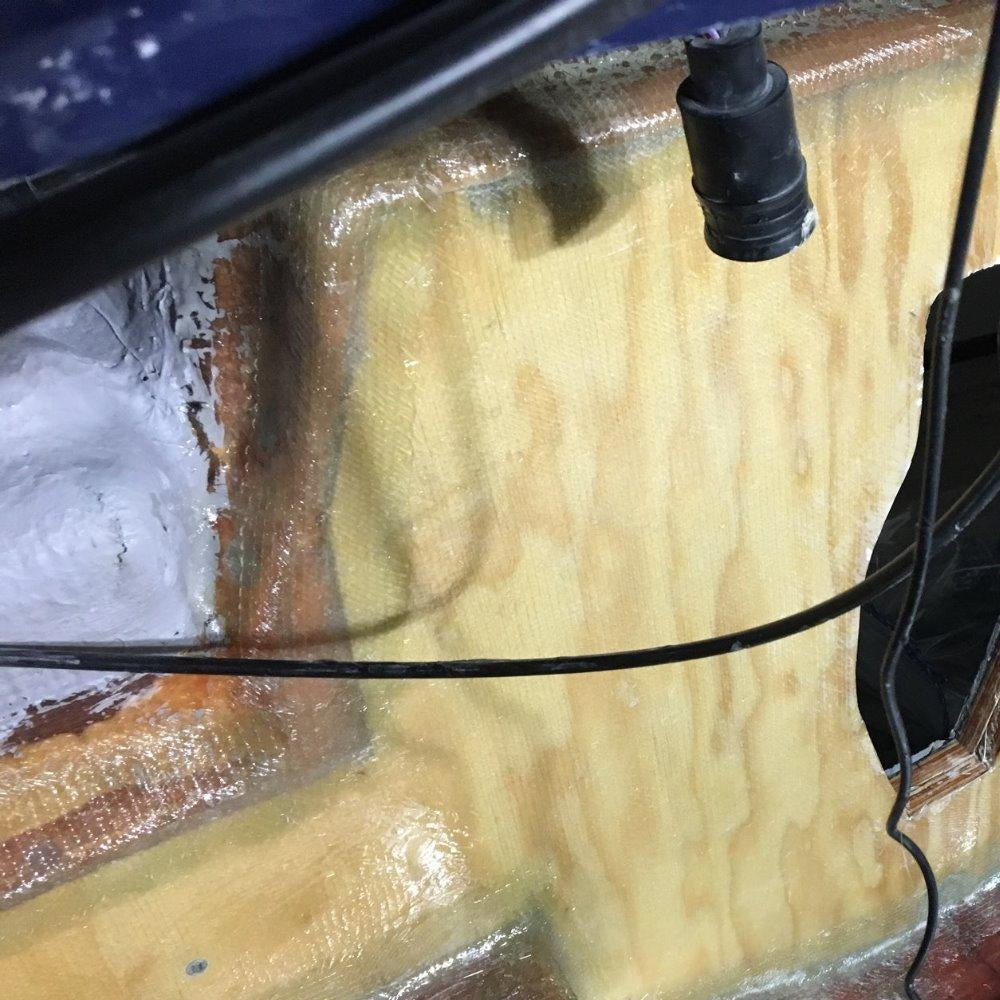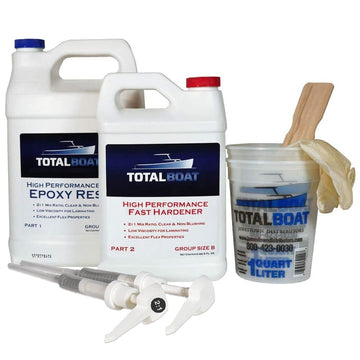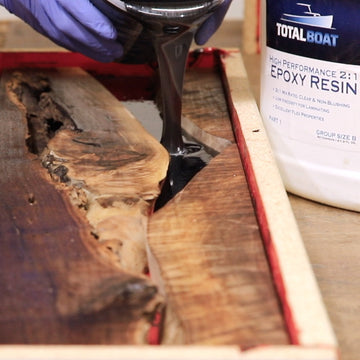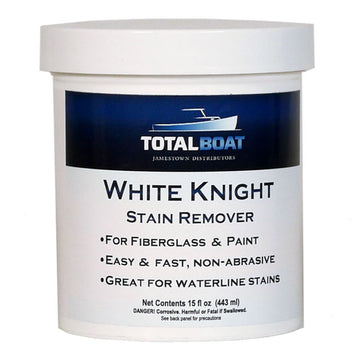STAYS TACKY FOR MAXIMUM ADHESION
IDEALS FOR LAYUPS AND LAMINATING
WETS OUT FIBERGLASS EASILY
WON'T SAG ON VERTICAL SURFACES
Polyester Laminating Resin
Polyester Laminating Resin
STAYS TACKY FOR MAXIMUM ADHESION
IDEALS FOR LAYUPS AND LAMINATING
WETS OUT FIBERGLASS EASILY
WON'T SAG ON VERTICAL SURFACES
Couldn't load pickup availability








Laminating resin is great for wetting out fiberglass fabrics and keeping them in position during layups
Tackiness is a good thing when you’re doing a fiberglass layup and need to keep building layers without having them harden up on you. TotalBoat Polyester Laminating Resin will not cure on its own in direct contact with air. It contains no wax to prevent creation of an oxygen barrier that would cause it to cure, so it stays tacky and won’t sag while you’re building up layers. Its viscosity is ideal for wetting out fiberglass mat and cloth. Apply a final coat of TotalBoat Polyester Finishing Resin (which does contain wax) that cures to a hard, tack-free finish ready for sanding, painting, or gelcoating.
Gel time depends on amount of hardener admixed
The following table indicates approximate gel times @ 70°F. Adjust the hardener level to slow down or speed up gel time. Cooler temperatures may require a higher percentage of hardener than warmer temperature conditions.
| Slow Gel Time | Medium Gel Time | Fast Gel Time |
| 20 minutes or more | 15-20 minutes | 10 minutes |
| 1 teaspoon of hardener per quart of laminating resin | 2 teaspoons of hardener per quart of laminating resin | 3 teaspoons of hardener per quart of laminating resin |
Polyester Laminating Resin Details
- Base coat resin for laminating applications
- Surface remains tacky so layers of fiberglass mat or cloth adhere to each other better during laminating.
- Will not sag on vertical surfaces.
- Does not require sanding between coats, or before a final coat with a polyester finishing resin.
- Contains no wax.
- Requires a final coat of polyester finishing resin containing wax to cure to a hard, tack-free finish.
- Application: Brush or plastic spreader
- Hardener: MEKP (methyl ethyl ketone peroxide), included
- Sizes: Available in Quart and Gallon Kits
TECHNICAL DATA
- Substrates: Acceptable Substrates: Polyester resin*, TotalBoat Polyester Fairing Compound*, previously gelcoated surfaces*, TotalBoat Polyester Structural Repair Putty*, metals (that have been ground or heavily sanded to a bare, shiny finish, before they have a chance to oxidize at all – this will vary depending on the metal), wood substrates sanded to a rough surface.
- *Substrates Notes: TotalBoat Polyester Resin can be applied directly to any catalyzed, uncured polyester resin-based products. Any cured polyester resinbased products must be dewaxed and any surface contaminants removed, then sanded.
- Unacceptable Substrates: Do not apply Polyester Laminating Resin to unknown composite substrates, cured or uncured epoxy substrates, epoxy fairing materials, plastics, glass, vinyl ester resins, ceramics, masonry, or concrete.
- Catalyzation Percentage: 1% MEKP, 9% Active (7-8 drops of MEKP per ounce)
- Application Method: Brush, Roller, Plastic Spreader
- Application Temperature/RH: 50-95°F (70-85°F is ideal for a proper cure), relative humidity 0-90%
- Working Time & Gel Time: Varies by mass and application thickness.
- Colorants/Tints: Colorants and tints are not commonly added, but can be added at a small percentage if they are compatible with polyester resin.
- Mold Release Agents: Mold release paste wax, PVA (polyvinyl alcohol)
- Wax Additive (Optional): Paraffin wax additive (sold separately). TotalBoat Polyester Laminating Resin does not contain wax.
- Resin Color: Blue
- NOTE: Polyester Laminating Resin will not cure on its own. However, it will cure to a clear/buff color if wax additive has been added to the final layer or PVA has been applied to the final layer).
- Catalyst: MEKP (methyl ethyl ketone peroxide), included; The acceptable range of catalyst is 1-2.2% based on ambient conditions and required working time. DO NOT use more or less catalyst with TotalBoat Polyester Resin products.
- Coverage (sq ft/gal): 12.8 @ 1/8"; 25.7 @ 1/16"; 51.3 @ 1/32:; Coverage estimates do not include any material wasted from application, which is generally 10-15%.
- Shelf Life: Six months from date of manufacture
- Thinner: Do not thin this product.
- Surface Prep Solvent: Acetone
- Cleanup Solvent: Acetone. Once cured, the product must be removed mechanically.
-

Polyester Laminating Resin
- Best for:
- Substrates:
- Color:
- Application method:
- Catalyst/percentage:
- Mold release agents:
- Contains an air dry agent:
- Application temperature/RH:
- Working time:
- Gel time:
- Thinner:
- Cleanup:
- Coverage:
- Units of measure:
- THIS ITEM
-

Polyester Laminating Resin
- Best for: Build coat resin for laminating & repairs
- Substrates: Polyester resin, TotalBoat Polyester Fairing Compound, previously gelcoated surfaces, TotalBoat Polyester Structural Repair Putty, metals (that have been ground or heavily sanded to a bare, shiny finish, before they can oxidize, and wood substrates sanded to a rough surface
- Color: Blue
- Application method: Brush or Roll
- Catalyst/percentage: 1% MEKP, 9% active (7-8 drops of MEKP per ounce)
- Mold release agents: Mold release paste wax, PVA (polyvinyl alcohol)
- Contains an air dry agent: No
- Application temperature/RH: 50-95°F (70-85°F is ideal); 0-90% RH
- Working time: Varies by mass and application thickness
- Gel time: Varies by mass and application thickness
- Thinner: Do not thin this product.
- Cleanup: Acetone. Once cured, it must be removed mechanically.
- Coverage: Approximately 12.8 sq ft/gal @ 1/8"; 25.7 sq ft/gal @ 1/16"; 51.3 sq ft/gal @ 1/32". Estimates do not account for waste.
- Units of measure: Quart and Gallon (includes MEKP catalyst)
YOU MAY ALSO LIKE
FREQUENTLY ASKED QUESTIONS
-
What is the difference between laminating resin and finishing resin?
Polyester resin comes in two forms, a laminating resin that does not contain wax, and a finishing resin that contains wax. Polyester laminating resin remains tacky to the touch and does not cure in the presence of air, making it ideal for layups. Polyester finishing resin contains wax, which allows the resin to cure. Finishing resin is typically used as the final coat in a layup. -
What is the difference between laminating resin and gelcoat?
Laminating Resin and Gelcoat are both polyester resins, use MEKP catalyst, contain styrene, and can be tinted with compatible colorants. However, Gelcoat typically contains ISO (isophthalic) resins that give it stronger UV and water resistance for use as a finish coat. Polyester Laminating Resin does not contain wax, is used in build layers only, is typically an orthophthalic resin, and has no UV resistance. -
What is the difference between polyester resin and epoxy resin?
Polyester resin is used more for fiberglass layups or if you’re going to finish a repair with gelcoat, as the polyester resin will bond to the gelcoat better than epoxy. Epoxy is ideal for adhesive applications because it cures fully when applied as a thin film. Epoxy resin does not shrink when cured, while polyester resin does, based on the amount of resin that’s poured. Epoxy is also not naturally UV resistant and it will not bond to polyethylene. -
Do I need to sand when using laminating resin?
No, sanding is not required between coats, or before a final coat with a polyester laminating resin. -
What is the shelf life of laminating resin once opened?
Shelf life is about six months to one year once it’s opened. To ensure maximum stability and to maintain optimum resin properties, resins should be stored in closed containers at temperatures below 77 degrees Fahrenheit, and away from heat sources and sunlight. It’s important to store it in a cool, dry space. -
What color is the laminated finish?
It comes clear, but with an amber tint. If aesthetics are important, look for products stating crystal clear. -
Can laminating resin be used for fiberglass layup on wood?
Yes, it holds very nicely. Apply a coat to the wood first. This will allow the wood to absorb some of the resin. Then apply an additional generous coat to the wood and lay your fiberglass. Apply additional resin to saturate the cloth. Use a brush to tab in any angles or radius bends. -
Do I have to add wax in order for it to dry?
Laminating fiberglass resin remains tacky unless you add wax to it for the final layers in your layup, or apply an airdry product, such as PVA (polyvinyl alcohol) to the surface. For a complete cure, you can also use a finishing type resin for the final layer, such as our TotalBoat Polyester Finishing Resin. -
Does it set up tacky or dry?
It contains no wax to prevent the creation of an oxygen barrier that would cause it to cure, so it stays tacky and won’t sag while you’re building up layers. It requires a final coat of Polyester Finishing Resin containing wax to cure to a hard, tack-free finish. Alternatively, you can add a paraffin wax additive to the laminating resin before catalyzing with MEKP. -
What is the working time for this product?
The gel time depends on the temperature during the time you are using it and how much hardener you use. Adjust the hardener level to slow down or speed up gel time. Cooler temperatures may require a higher percentage of hardener than warmer temperature conditions. At 70 degrees F, one teaspoon of hardener per quart of resin will give you about 20 minutes to Gel time, 2 teaspoons will give 15-20 minutes and 3 teaspoons will give about 10 minutes.



































